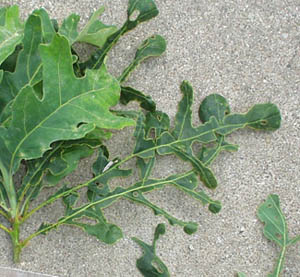Oak Tatters Tidbit | |
|---|---|
| October 22, 2008 | |
|
“Oak tatters” is the name for a condition we see each spring in Illinois on oak. The foliage looks as though it has been eaten by an insect, leaving only the major veins and a bit of tissue around the veins intact. The foliage is not scorched or necrotic. What is left on the leaf is green. The foliage appears lacy, as in the image, and the canopy appears thinned. In issue no. 9 (2008) of this newsletter, we discussed this recurring problem in Illinois. I told you that current research points to chemical injury as the cause of oak tatters. In 2004, three researchers at the University of Illinois did a preliminary study that indicated that drift of chloroacetamide herbicides (possibly from applications onto corn and soybean fields) was a possible cause of the leaf tatters syndrome. The researchers are Jayesh Samtani, John Masiunas, and Jim Appleby. The group submitted an article to the Hort Science journal in June 2008. That article reports results of the third set of experiments showing symptoms following chloroacetamide herbicides. The article was accepted and should be in print shortly. Watch Hort Science articles this winter for more. I spoke with Dr. Appleby about oak tatters in 2008. Although we saw it on one Plant Clinic oak this year for the first time, in general the condition was not as prevalent this year. Dr. Appleby speculates that the wet spring prevented spraying of fields until after oak foliage was already expanded and more tolerant of the chemicals. For the record, the Plant Clinic oak has recovered nicely this year. Only time will determine the long-term effect of tatters. | |
| Author: | Nancy Pataky |

